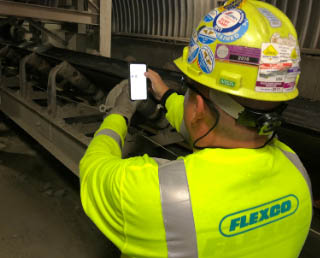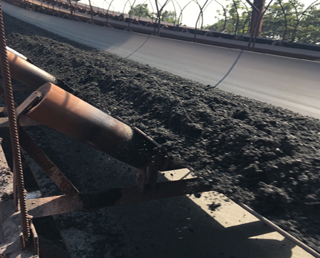‘Tis the Season for an Assessment … Or Is It?
 Flexco recommends all belt conveyor systems receive a thorough review at least once per year, but what time of year is the best to have this done? Well to tell you the truth, there is no good answer for this because it depends on your business and how it operates.
Flexco recommends all belt conveyor systems receive a thorough review at least once per year, but what time of year is the best to have this done? Well to tell you the truth, there is no good answer for this because it depends on your business and how it operates.
For some, getting an assessment done at the end of the busy season is preferred because it allows you some time to address the challenges that were identified during the review of your belt conveyor system.
For some, getting an assessment done right before you get your busiest is essential to identifying and fixing any potential problems that could hold up production. There’s always the option of doing both, because no one ever said you could only take a holistic look at your system once a year.
What goes into an assessment?
Regardless of your choice, the assessment should ideally be done by a third party, who provides a fresh perspective on your operation. I cannot tell you how often people have told me they didn’t realize they had a problem or that there was a solution to something that always bugged them. An assessment can be very eye-opening.
The assessment should be comprehensive, reviewing every component of the system, to help identify potential problems and proactively address any maintenance issues. So what are the most common belt conveyor challenges found during an assessment? Carryback, Mistracking, Spillage, and Slippage.
Carryback
Conveyor belt carryback is one of the most common and most costly issues impacting an operation. While material sticking to the conveyor belt may seem like an inevitable “cost of doing business,” it presents real concerns and challenges. In fact, CEMA conservatively estimates carryback to be as high as three tons per week, given a 60" wide belt traveling at 800 feet per minute. Over the course of a full year, this is over 150 tons of material for one belt. If carryback on a conveyor can be reduced from 3% to 1%, it can result in a 67% reduction in conveyor maintenance costs.
Carryback can lead to conveyor belt damage and/or downtime, lost productivity, and possibly even safety hazards. It can be easy for someone who works with the conveyor belt every day to overlook or disregard clear signs of carryback, further underscoring the need for a fresh set of eyes available from an outside assessment.
Mistracking
 Where there is carryback, there is likely to be conveyor belt mistracking. Buildup on the rollers can cause the belt to drift to one side, but mistracking can also be caused by uneven belt wear, an incorrect splice, or off-center loading. All of these issues can be identified in an independent belt conveyor assessment.
Where there is carryback, there is likely to be conveyor belt mistracking. Buildup on the rollers can cause the belt to drift to one side, but mistracking can also be caused by uneven belt wear, an incorrect splice, or off-center loading. All of these issues can be identified in an independent belt conveyor assessment.
Preventing mistracking is essential, as even slightly misaligned conveyor belts can lead to spillage, excessive wear of the belt, and major damage to equipment or even the structure.
Spillage
The third most commonly found problem in a belt conveyor assessment is spillage. Conveyer belt spillage can negatively affect the efficiency of an operation through material loss, damage to equipment, and the extra time and expense needed to clean it. It can also pose a significant threat to worker safety and the operation’s environmental impact.
Because conveyer belt spillage can occur anywhere along the line, a comprehensive assessment of the entire system is the most effective approach to identify occurrences.
Slippage (aka Belt Slip)
Weather conditions. Improper setup of the system. The very material you carry. All of these issues can contribute to the pulley not gripping the belt properly, leading to conveyor belt slippage. Conveyor belt slippage is a common problem that can force your entire system to work harder, causing unnecessary wear and tear and eventually downtime and repairs.
A complete belt conveyor assessment can help you identify why and where slippage is occurring or likely to occur and address the problem before it becomes even more costly.
Your operation … your choice
When you schedule your belt conveyor assessment isn’t nearly as important as just getting one on the calendar on a yearly basis. Scheduling your annual belt conveyor assessment will help you stay ahead of costly and potentially dangerous problems that can easily be caught with a careful inspection.
Click here to schedule an assessment with your local Flexco expert.
Authored By: Kevin Fales, Product Manager
Fales manages the belt conveyor product (BCP) line, providing product development and engineering with guidance on market requirements for both new product concepts and existing products. He also leads the development of technical and promotional literature supporting BCP line. Fales graduated from Grand Valley State University with a bachelor’s degree in Marketing, and from Western Michigan University with a Master of Business Administration.
Subscribe to the Flexco Blog
Related Blogs
Published Date
November 26, 2019Product Groups
- Belt Cleaning Systems
- Belt Positioners, Trackers, and Trainers
- Impact Beds and Skirting Systems
Issues
- Belt Wear
- Blade Life
- Carryback
- Downtime
- Maintenance
- Slippage
- Spillage